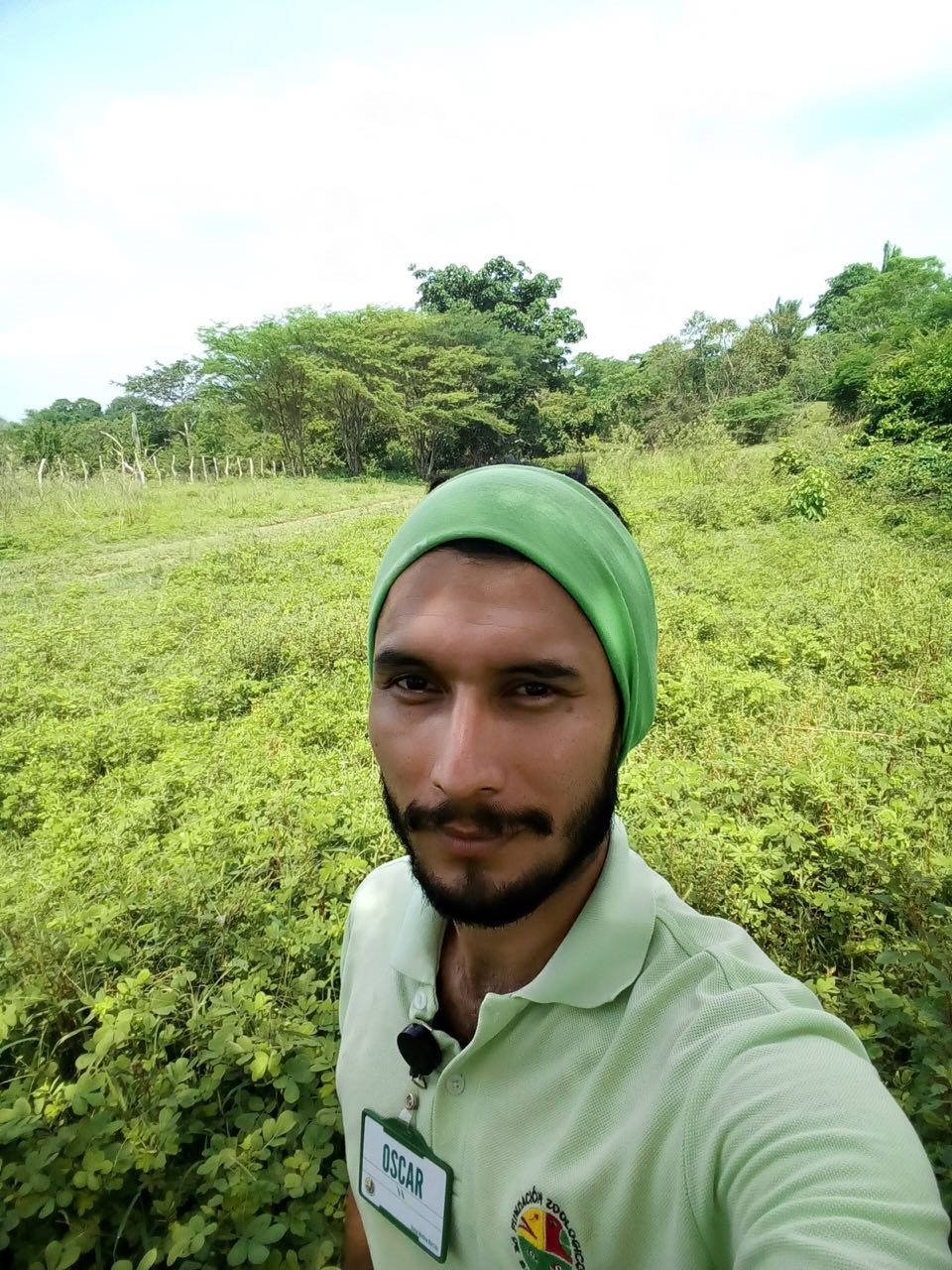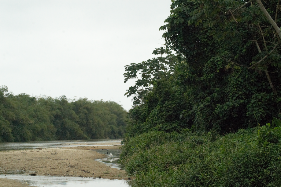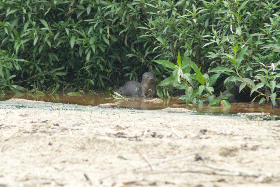IUCN/SSC Otter Specialist Group Bulletin

©IUCN/SCC Otter Specialist Group
Volume 37 Issue 3 (November 2020)
Citation: Medina-Barrios, O (2020). Approach to a Qualitative Methodology for the Search and Direct Detection of the Neotropical Otter (Lontra longicaudis Olfers, 1818)a. IUCN Otter Spec. Group Bull. 37 (3): 140 -146
Approach to a Qualitative Methodology for the Search and Direct Detection of the Neotropical Otter (Lontra longicaudis Olfers, 1818)
Oscar Medina-Barrios1*
1Animal Care Coordinator, Fundación Botánica y Zoológica de Barranquilla, Cl. 77 # 68-40 Barranquilla, Colombia. Email::o.medina@zoobaq.org
(Received 11th November 2019, accepted 29th January 2020)
Abstract: The Neotropical otters (Lontra longicaudis) are semi-aquatic mammals. In general, they have the habit of defecating in conspicuous places of the body of water or in adjacent terrestrial ecosystems. Being a non-invasive method, tracking is an important tool for the study of threatened species or animals that are difficult to observe. For this reason, the present work aims to make an approach to a qualitative methodology for the search and direct detection of the Neotropical otter using fresh faeces. During February 2015, two diurnal routes were carried out on Palomino River and Jordan River (Colombia) with 3 and 2 km respectively, searching latrines on riverbeds and banks in conspicuous places, selecting those with fresh faeces (no older than 12 hours) as fixed observation stations to increase the probability of detection of L. longicaudis. Five observation points were defined in each river: at the Palomino River 104 latrines were found, 14 of them with fresh faeces and direct observation was achieved four times; 24 latrines were found at the Jordan River, all of them old and therefore, there was no direct detection of the species. The methodology proposed here is purely qualitative and aims to increase the probability of detection and direct observation of the Neotropical otter in the dry season of the year.Keywords: faeces, tracking, semi-aquatic mammals, Colombia
The Neotropical otter (Lontra longicaudis) is a semi-aquatic mammal with a wide geographical distribution, occurring from Mexico to Argentina (Waldemarin and Colares, 2000; Arellano et al., 2012; Medina-Barrios and Morales-Betancourt, 2019). Generally, they defecate in conspicuous places of water bodies (Wemmer et al., 1996; Kasper et al., 2004; Medina-Barrios and Morales-Betancourt, 2019) or in adjacent terrestrial ecosystems (Medina-Barrios and Morales-Betancourt, 2019). As a result, most studies with the species taking account this behavior for the definition of occurrence areas (Chehébar, 1985; Chehébar et al., 1986; Kasper et al 2004; Medina-Barrios and Morales-Betancourt, 2019) and for diet studies (Beja, 1991; Brezinski et al., 1993; Passamani and Camargo, 1995; Pardini, 1998; Quadros and Monteiro-Filho, 2000; 2001; Kasper et al., 2004; Medina-Barrios and Morales-Betancourt, 2019).
Scats are the most evident and most easily recognizable signal (Liebenberg, 2000; Chame, 2003). In this sense, and being a non-invasive method, scat surveys are an important tool for the study of threatened species or animals that are difficult to observe, and can also be applied to the study of rare or nocturnal animals. Although a well-trained observer is required, its low cost and accessible technology makes scat tracking a good choice for field studies (Chame, 2003).
For this reason, the present work aims to make an approach to a qualitative methodology for the search and direct detection of Neotropical otters in clear water rivers of northern Colombia, using fresh faeces as main indicator; in addition, is a contribution to the knowledge of the species. This study was possible through the agreement signed between the environmental authority of La Guajira (Colombia) and the Omacha Foundation in 2015 for the conservation of the species in the region, with a focus on the Montes de Oca Protective Forest Reserve (Medina-Barrios and Morales-Betancourt, 2019).
METHODOLOGY
During February 2015, two diurnal routes were carried out in both the middle and the lower part of two rivers (starting at 6:00 hrs and ending at 17:00 hrs), one at the Palomino River (Palomino, La Guajira-Colombia: N 11° 14' 22.2”; W 73° 33' 37.6”) and another one at the Jordan River (Montes de Oca Protective Forest Reserve, Carraipía, La Guajira-Colombia: N 11o 10’ 02.5”; W 072o 23’ 00.3”) of 3 and 2 km respectively (Figure 1), searching their riverbeds and banks for latrines in conspicuous places such as rocks and / or stagnant logs, in order to select those that had fresh faeces no older than 12 hours. These places would then be used as fixed observation stations to increase the opportunity of detection of L. longicaudis (Medina-Barrios and Morales-Betancourt, 2019).
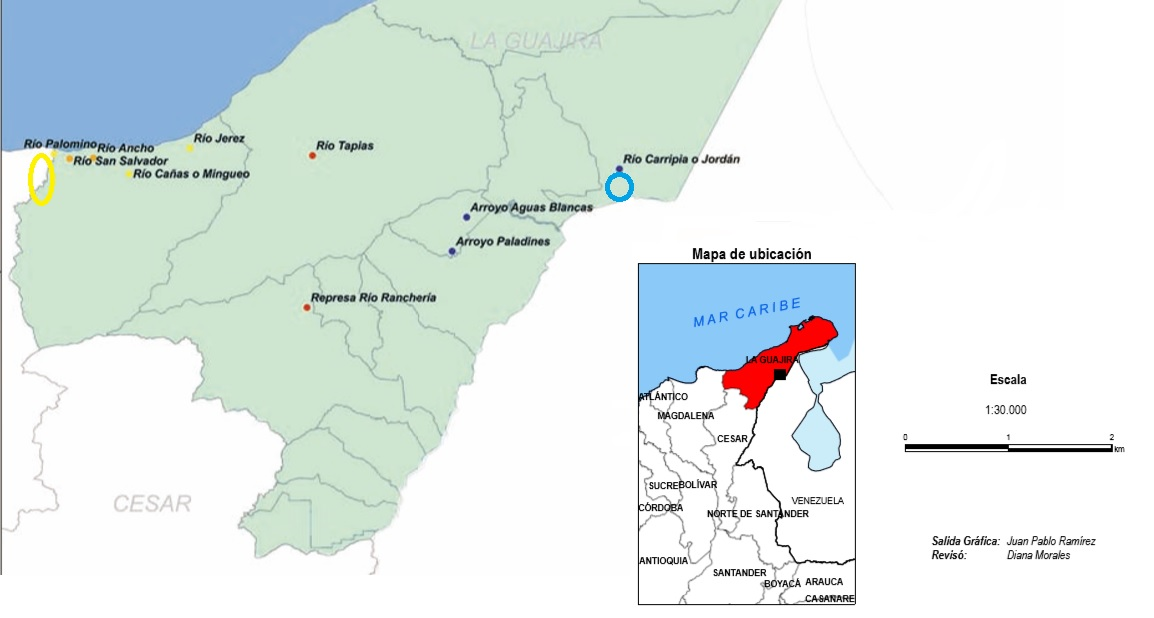
This amount of time was defined since in longer periods the excrement dries up and it is difficult to determine if the deposition is recent. Fresh, viscous spraints, with or without anal gelatin and a very strong fishy and musky smell were considered fresh (Figure 2). It must be consider that this smell was very pronounced in the early hours of the morning or when the spraint was recently excreted and decreased in intensity as the time passed; however, at the end of the afternoon the scent was still preserved. The color of the faeces was not considered within the established period of time, since these varied according to the diet or the abundance of the food resource.
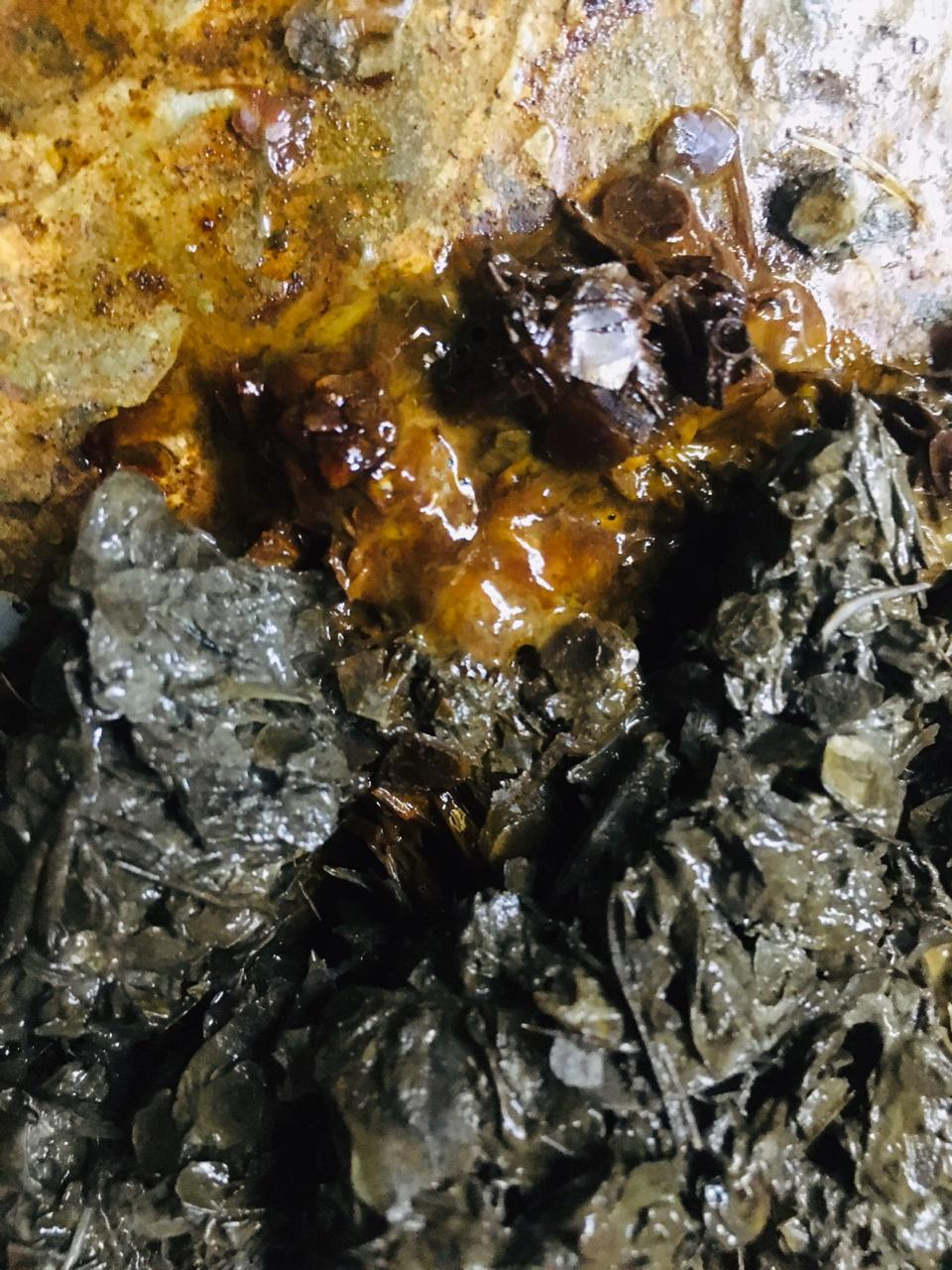
Regarding the choice of fixed stations for the observation of L. longicaudis, in the Palomino River, five points were selected for sighting for a period of nine days and a sampling effort of 41 hours (Medina-Barrios and Morales-Betancourt, 2019) and for the Jordan River, five observation points were selected alike, but for five days and a sampling effort of 42 hours. The difference in the days of sampling and in the choice of places were due to the difficulty of entering the monitored sites (Table 1); in addition, in the selection of the observation sites, it was taken into account that they were hidden at a distance of no less than 20 m from the latrine.
| Table 1: Observation stations in the Palomino (P) (Medina-Barrios and Morales-Betancourt, 2019) and Jordan (J) Rivers; department of La Guajira, Colombia. | |||||
| Designation | Geographic position | Meters above sea level | |||
| P1 | N 11o 14’ 54.7”; W 073o 34’ 05.4” | 16 | |||
| P2 | N 11o 14’ 46.6”; W 073o 34’ 04.1” | 16 | |||
| P3 | N 11o 13’ 54.3”; W 073o 34’ 04.6” | 181 | |||
| P4 | N 11o 13’ 02.8”; W 073o 34’ 50.9” | 22 | |||
| P5 | N 11o 12’ 59.4”; W 073o 34’ 53.6” | 22 | |||
| J1 | N 11o 10’ 17.0”; W 072o 22’ 52.0” | 259 | |||
| J2 | N 11o 10’ 03.7”; W 072o 23’ 01.9” | 257 | |||
| J3 | N 11o 10’ 38.9”; W 072o 22’ 45.2” | 245 | |||
| J4 | N 11o 10’ 01.6”; W 072o 22’ 57.3” | 248 | |||
| J5 | N 11o 10’ 37.0”; W 072o 22’ 44.8” | 247 | |||
RESULTS
Palomino River
In the monitored river segment, 104 latrines were registered, 14 of which contained fresh faeces. Using this methodology of active search for fresh spraints and selection of observation points, it was possible to register L. longicaudis four times, in four different days, three of them in the same latrine, observation station P1. The fourth sighting occurred during the morning in the observation station P2 (Table 1), which is approximately 200 m from P1 (Medina-Barrios and Morales-Betancourt, 2019), near the confluence with the sea, and closest to an urban area (Palomino). There was a marked difference in the places of stool deposition: while in the middle part of the river the faeces were found mainly on conspicuous rocks near the shore (in and out of the riverbed), in the lower part of the river the faeces were located on floating or stagnant logs (Figure 3).
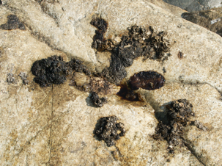
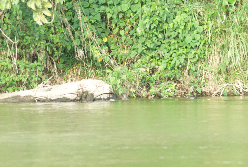
Jordan River
Although the Jordan River has ideal conditions to be the habitat of the Neotropical otter and to allow effective sightings, no L. longicaudis activity was detected following the methodology proposed in this study, since no fresh or recently deposited faeces were found. Therefore there were no direct detections. A completely dry latrine with pale stool and crumbly upon contact was considered old; there were 24 latrines with quite old faeces; one of those latrines worked also as a feeding site (Figure 4).
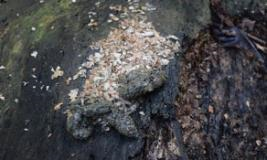
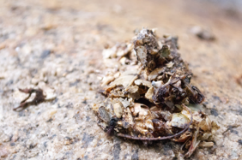
DISCUSSION
Palomino River’s latrine surroundings presents characteristics that make them suitable (without being ideal due to anthropic intervention) for otter activity, with shrubs, herbaceous plants and tree branches on the riverbank in contact with water (Figure 5), as reported by Santos and Reis (2012).
As mentioned by Waldemarin (2004), who found that in areas near margins where the vegetation were more heterogeneous, latrines were grouped into zones with a certain degree of conservation, being used as places of fishing and / or escape, corresponding to the data collected in this study.
This section of the riverbed, in its lower part near its mouth, is a potential place of direct observation of the species to continue monitoring its behavioral repertoires (Medina-Barrios and Morales-Betancourt, 2019) and the way L. longicaudis uses this habitat as a foraging area.
Although there is no direct sighting at the stations carried out in the middle part of the river section, using the same time schedule, latrines with fresh faeces were detected, suggesting that possibly in these places the activity patterns are different due to the lower degree of human intervention, as well as having more inconspicuous places to hide when there are people nearby. Even so, the observation sectors in this area of the riverbed represent potential monitoring sites because, the fact that fresh faeces have been found, shows the use of such habitat.
As for the Jordan River, the absence of L. longicaudis may indicate a seasonal use that varies according to the rainy and dry periods. However, it is necessary to broaden the search in the river upstream, in addition to monitoring in times of precipitation, to determine whether such climatic factors are used by L. longicaudis in movement activities.
Therefore, it is necessary to assess the current state of knowledge of the Neotropical otter in this river with respect to its biology and ecology because such data are still insufficient.
CONCLUSIONS
The fresh-latrine searching methodology proposed here is purely qualitative and aims to increase the probability of detection and direct observation of the Neotropical otter in the dry seasons of the year, since rains and similar climatic phenomena will affect the traces left by the species; with this methodology, inquiries could be made about current uses of the habitat by Neotropical otters in a given place, seasonality, as well as determining hunting pressures and / or general state of the ecosystem through the presence / absence in areas where historically the species occurred.
Acknowledgements: The author wants to thank all the colleagues at the Omacha Foundation, Corpoguajira and the local community of Palomino and Carraipía.
REFERENCES
Arellano, E. Sánchez Núñez, E. Mosqueda Cabrera, M.A. (2012). Distribución y abundancia de la nutria Neotropical (Lontra longicaudis annectens) en Tlacotalpan, Veracruz, México. Acta Zoológica Mexicana, 28: 270-279. [In Spanish]
Beja, P.R. (1991). Diet of otters (Lutra lutra) in closely associated freshwater, brackish and marine habitats in south-west Portugal. Journal of Zoology, 225: 141-152
Blacher C. (1987). Ocorrência e preservação de Lutra longicaudis (Mammalia: Mustelidae) no litoral de Santa Catarina. Boletim da Fundação Brasileira para Conservação da Natureza, 22: 105-117. [In Portuguese]
Brezinski, M., Jedrezejewski, W., Jedrezejewska, B. (1993). Diet of otters (Lutra lutra) inhabiting small rivers in the Bialowieza National Park, eastern Poland. Journal of Zoology, 230: 495-501.
Chame, M. (2003). Terrestrial mammal faeces: a morphometric summary and description. Memórias do Instituto Oswaldo Cruz, Rio de Janeiro, Vol. 98(Suppl. I): 71-94.
Chehébar, C.E. (1985). A survey of the southern river otter Lutra provocax Thomas in Nahuel Huapi National Park, Argentina. Biological Conservation, 32: 299-307.
Chehébar, C.E., Gallur, A., Giannico, G., Gotelli, M.D., Yorio, P. (1986). A survey of the southern river otter Lutra provocax in Lanin, Puelo and los Alerces National Parks, Argentina, and evaluation of its conservation status. Biological Conservation, 38: 293-304.
Corpoguajira y Fundación Omacha. (2015). Plan de Manejo para la Conservación de la Nutria Neotropical (Lontra longicaudis) en el departamento de La Guajira. Bogotá: Corpoguajira y Fundación Omacha.
Kasper, C.B., Feldens, M.J., Salvi, J., Zanardi Grillo, H.C. (2004). Estudo preliminar sobre a ecologia de Lontra longicaudis (Olfers) (Carnivora, Mustelidae) no Vale do Taquari, Sul do Brasil. Revista Brasileira de Zoologia 21 (1): 65-72. [In Portuguese]
Liebenberg, L. (2000). Tracks and Tracking in Southern Africa, Struik Publishers, Cape Town, 144 pp.
Medina-Barrios, O., Morales-Betancourt, D. (2019). Notes on the Behaviour of Neotropical River Otter (Lontra longicaudis) in Palomino River (La Guajira, Colombia). IUCN Otter Specialist Group Bulletin 36 (1): 34-47.
Pardini, R. (1998). Feeding ecology of the Neotropical river otter Lontra longicaudis in an Atlantic Forest Stream, south-eastern Brazil. Journal of Zoology 245:385-391.
Passamani, M., Camargo, S.L. (1995). Diet of the river otter Lontra longicaudis in Furnas Reservoir, south-eastern Brazil. IUCN Otter Specialist Group Bulletin, 12: 32-34.
Quadros, J., Monteiro-Filho, L.A. (2000). Fruit occurrence in the diet of the Neotropical otter, Lontra longicaudis in southern Brazilian Atlantic forest and its implication for seed dispersion. Mastozoologia Neotropical, 7:33-36.
Quadros, J., Monteiro-Filho, E.L.A. (2001). Diet of the Neotropical otter, Lontra longicaudis, in Atlantic Forest area, Santa Catarina State, Southern Brazil. Studies on Neotropical Fauna and Environment, 36 (1): 15-21.
Santos, L.B., Reis, N.R. (2012). Use of shelters and marking sites by Lontra longicaudis (Olfers, 1818) in lotic and semilotic environments. Biota Neotropica, 12 (1): 199-205 http://www.biotaneotropica.org.br/v12n1/en/abstract?article+bn02512012012
Waldemarin, H.F. (2004). Ecologia da lontra neotropical (Lontra longicaudis), no trecho inferior da bacia do Rio Mambucaba, Angra Dos Reis. PhD Thesis. Universidade do Estado do Rio De Janeiro, Instituto de Biologia Roberto Alcântara Gomes, Programa de Pós-Graduação em Biología Área de Concentração em Ecología. [In Portuguese]
Waldemarin, H.F., Colares E.P. (2000). Utilisation of resting sites and dens by the Neotropical river otter (Lutra longicaudis) in the South of Rio Grande do Sul State, Southern Brazil. IUCN Otter Specialist Group Bulletin, 17 (1): 14 – 19.
Wemmer, C., Kuns, T.H., Lundie-Jenkins, G., Mcshea, W.J. (1996). Mammalian sign. In: Wilson, D.E., Cole, R.F., Nichols, J. D., Rudan, R., Foster, M.S. (Eds). Measuring and monitoring biological diversity, standard methods for mammals. pp. 157-176. Washington, Smithsonian Institution Press.
Résumé: Approche d’une Méthodologie Qualitative pour le Recherche d’une Detection Directe la Loutre à Longue Queue Lontra LongicaudisOlfers, 1818)
Les loutres longue à queue (Lontra longicaudis) sont des mammifères semi-aquatiques. En général, ils ont pour habitude d’épreindre dans des endroits bien visibles de la masse d'eau ou dans les écosystèmes terrestres adjacents. En tant que méthode non invasive, ce suivi est un outil important pour l'étude des espèces menacées ou des animaux difficiles à observer. Pour ce motif, le présent travail vise à mettre en œuvre une approche méthodologique qualitative destinée à la recherche et à la détection directe de la loutre à longue queue à l'aide d’épreintes fraîches. En février 2015, deux itinéraires diurnes, de 3 et 2 km respectivement, ont été réalisés le long des rivières Palomino et Jourdain (Colombie). A cette occasion, nous avons cherché des latrines sur les lits des rivières et sur les berges à des endroits bien visibles et avons sélectionné celles contenant des excréments frais (pas plus de 12 heures) comme stations fixes d'observation pour augmenter la probabilité de détection de L. longicaudis. Cinq points d'observation ont été définis dans chaque rivière : sur la rivière Palomino, 104 latrines ont été trouvées, dont 14 avec des épreintes fraiches et une observation directe a été réalisée quatre fois ; 24 latrines ont été trouvées au bord du Jourdain, toutes anciennes et par conséquent, il n'y a pas eu de détection directe de l'espèce. La méthodologie proposée ici est purement qualitative et vise à augmenter la probabilité de détection et d'observation directe de la loutre à longue queue, en saison sèche, au cours de l'année.
Revenez au dessus
Resumen: Aproximación a una Metodología Cualitativa para la Búsqueda y Detección Directa de la Nutria Neotropical (Lontra longicaudis Olfers, 1818)
La nutria neotropical (Lontra longicaudis) es un mamífero semiacuático. En general, ellas tienen el hábito de defecar en lugares conspicuos del cuerpo de agua o en ecosistemas terrestres adyacentes. Siendo un método no invasivo, el rastreo constituye una importante herramienta para el estudio de especies amenazadas o animales difíciles de observar. Por tal motivo, el presente trabajo tiene por objetivo realizar una aproximación a una metodología cualitativa para la búsqueda y detección directa de la nutria neotropical utilizando heces frescas. Durante el mes de febrero del 2015 se realizaron dos recorridos diurnos tanto en la parte media como en la parte baja, uno en el río Palomino y otro en el río Jordan (3 y 2 km respectivamente), por sus cauces y orillas para la búsqueda de letrinas en lugares sobresalientes del agua, con el fin de seleccionar aquellas que tuvieran heces frescas no mayores a 12 horas de depositadas, para utilizar estos lugares como estaciones de observación fija y aumentar las probabilidades de detección de L. longicaudis. Se realizaron cinco puntos de observación en cada río: en el rio Palomino se encontraron 104 letrinas, 14 de ellas con heces frescas y se logró realizar observación directa en cuatro ocasiones; en el río Jordan se hallaron 24 letrinas, todas antiguas y por consiguiente, no hubo detección directa de la especie. La metodología aquí propuesta es netamente cualitativa y pretende aumentar la probabilidad de detección y observación directa de la nutria neotropical en las temporadas secas del año.
Vuelva a la tapa
